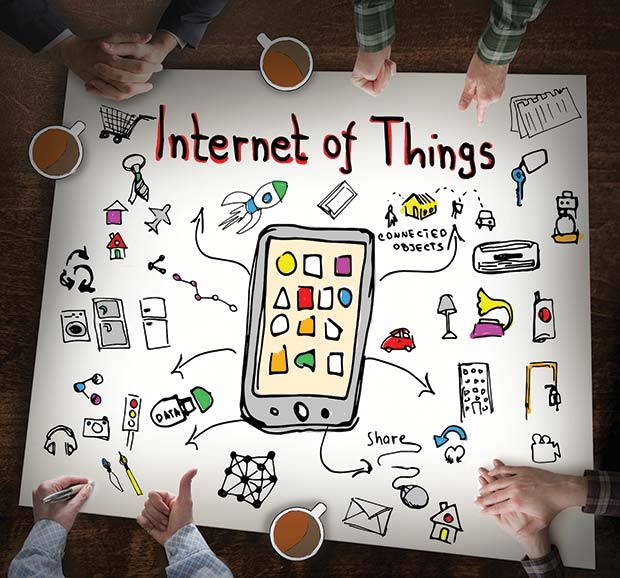The retail industry is not traditionally shy of embracing new technology and welcomes innovation and the opportunity to increase profitability with open arms. From easy-pay and ordering solutions, advertising generated from specific data e.g. sending invitations to a Wedding Show to everyone in a local radius who has changed their Facebook status to engaged, to the dishwasher that emails you to tell you to add dishwasher salt to your shopping list; the Internet of Things is not unlike astronomy; when you start thinking about its size and possibilities, you can’t quite get your head around the concept of infinite options. Business Insider estimates there will be in excess of nine billion devices enabled for the Internet of Things by 2018, and the retail industry has the opportunity to enhance the customer experience, reduce costs and increase value by embracing collaboration with other industries.
 Imad Mouline, CTO of Everbridge explains, “The Internet of Things (IoT) is without a doubt one of the most buzzed about topics in our tech-obsessed culture right now. While I agree that the near-endless possibilities of how the consumer side of IoT will transform our everyday lives for the better, making things simpler and more connected, it’s not the only angle our society should focus on. There is a huge opportunity for the industrial IoT to impact the world significantly – especially in critical situations. Mainstream attention is being paid to machine-to-machine communications, but a whole host of new technologies are maturing to make these communications even more actionable during critical situations. This is the real future of our “connected” world. Our ability to connect machines to people for immediate action will continue to improve the way we communicate, work and live.”
Imad Mouline, CTO of Everbridge explains, “The Internet of Things (IoT) is without a doubt one of the most buzzed about topics in our tech-obsessed culture right now. While I agree that the near-endless possibilities of how the consumer side of IoT will transform our everyday lives for the better, making things simpler and more connected, it’s not the only angle our society should focus on. There is a huge opportunity for the industrial IoT to impact the world significantly – especially in critical situations. Mainstream attention is being paid to machine-to-machine communications, but a whole host of new technologies are maturing to make these communications even more actionable during critical situations. This is the real future of our “connected” world. Our ability to connect machines to people for immediate action will continue to improve the way we communicate, work and live.”
The Internet of Things is simply the network of physical objects embedded with electronics, software, sensors, and network connectivity, which enables these objects to collect and exchange data. When we consider its current and potential benefit to the retail industry, the key elements are sensors and network connectivity (although nobody denies that both are comparatively impotent without electronics and software). If sensors are positioned and programmed correctly, they can tell you when stock items are low, they can tell you if optimum storage temperatures are not reached and maintained, they can monitor attendance and efficiency of your workforce, and they can identify and report procedural and maintenance problems (e.g. too much weight on a fork-lift or shelving, conveyor belt failure). Automated stock control and orders can be sensor driven, stock quality can be measured, and the list is truly infinite; the beauty of IoT is that it doesn’t stop with the detection and identification (e.g. minimum temperature in the cold store), by connecting different devices it can seek a resolution (test the thermostat and its setting, check power supply), and inform either another device (switch to alternate thermostat or power supply), or a person (texting maintenance and warehouse manager). These are all simple examples that are only the tip of the iceberg when considering how much the IoT can benefit the retail industry.
There may be no limit to the potential of The Internet of Things but without connectivity the Smartphone is just a phone, and the Smartfridge just keeps your beer cold. Keeping connected and reducing downtime is crucial now and in the future. Incidents that affect Retail IT Operations are spontaneous, and can occur at any hour. The appropriate responders, selected for their skills, availability and location, need to be dispatched based on the particular business interruption, such as software or network failures. An effective Critical IT Alerting program ensures that these interruptions are organised and prioritised by incident type, location and severity, and will be able to identify the most skilled, available IT expert, and supply them with up-to-date information to make repairs. If that expert is not contactable, the IT alerting solution can find the next available engineer and contact them; continuing the process until confirmation is received that someone is en-route to make the repairs. If the downtime is likely to impact on stakeholders and customers, they too can be contacted and kept updated. The way businesses manage IT downtime, ultimately reducing the mean time to resolution, can be enhanced by Everbridge’s IT Alerting solution.

Everbridge IT Alerting can be integrated with an ITSM platform and uses automatic escalation of alerts, on-call scheduling, mobile alerting and more to automate manual tasks and keep IT Operations teams collaborative at all times. With IT Alerting you have the ability to centralise your alerting management with one system that manages escalation and on-call tracking, while still automatically triggering notifications from your infrastructure, application, and network performance management monitoring systems. Because Everbridge IT Alerting uses multi-modal alerting, it can broadcast messages even when connectivity is weak or unavailable.
The impact of downtime in a retail environment negatively affects work output, sales and ultimately business reputation, so reducing the mean time to resolve IT issues must be paramount in a world where the Internet of Things is growing daily and influencing every aspect of business.
![]() Imad Mouline concludes, “Communication is a crucial factor in all the components of critical IT incident resolution, with an IT Alerting system it doesn’t have to be challenging and the cost of downtime to a company can be significantly reduced.”
Imad Mouline concludes, “Communication is a crucial factor in all the components of critical IT incident resolution, with an IT Alerting system it doesn’t have to be challenging and the cost of downtime to a company can be significantly reduced.”
blog: www.everbridge.com/blog
Twitter: twitter.com/everbridge
Facebook: facebook.com/everbridgeinc?fref=ts




Comments are closed.